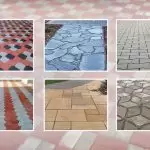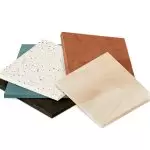Paver blocks, also known as paving stones, are manmade materials used to construct hard surfaces such as patios, driveways, walkways, and pool decks. With numerous shapes, patterns, textures, and material options available, selecting the right paver blocks may seem confusing. Read on for a detailed guide on types of pavers, key benefits, design considerations, installation factors, and vital upkeep tips when working with paver blocks for your outdoor hardscaping needs.
Post your Requirement
Types of Paver Blocks
Paver blocks are primarily categorized by the materials used to manufacture them:
- Concrete Pavers: Offer the widest variety in terms of shapes, colors, textures and strength. Made by mixing cement, aggregates, and water. Economic option.
- Clay Brick Pavers: Made from clay and extremely durable. Provide a classic, natural look. Porous to allow drainage.
- Granite Pavers: Extremely strong and resist damage but very expensive. Withstand constant foot traffic.
- Travertine Pavers: Made from limestone, giving light earthy colors. Installed for pool decks due to anti-slip texture.
- Sandstone Pavers: Consists of naturally cemented sand grains. Available in rich reddish-brown earth tones but requires sealing. Limestone Pavers: Offer subtle natural grayish and dark brown shades. Prone to staining so needs regular sealing.
Key Benefits of Paver Blocks
Key Benefits of Paver Blocks typically include:
- Aesthetic Appeal: Available in numerous styles, shapes, colors and laying patterns like herringbone. Enhances ambiance.
- Eco-friendly: Permeable pavers allow rainwater absorption reducing runoff. Made from recycled materials.
- Customization: Create unique designs, names or patterns in the patio or pathways with specialized molding techniques of concrete pavers.
- Durability: Extremely resilient and long-lasting retaining structural integrity for over 25-50 years.
- Skid-Resistance: Provides excellent grip with hardly any risk of slipping reducing injuries. Anti-slip grits can be added as well.
Guide to Assessing Paver Block Excellence
Inspecting blocks across below mentioned parameters and consulting construction experts facilitates identifying durable, high-performing paver blocks suited for your installation needs. Follow the given steps:
- Check dimensions – Blocks should have consistent sizing and shaping.
- Evaluate surface – Smooth, uniform finish enhances aesthetics.
- Assess color consistency – Even coloring is visually appealing.
- Test strength and durability – Blocks must bear expected loads.
- Measure water absorption – Lower rates increase lifespan.
- Check weathering resilience – Should tolerate freeze-thaw cycles.
- Assess traction – Sufficient friction prevents slipping.
- Gauge thickness uniformity – Consistent depth enables stability.
- Inspect joint sizes – Proper alignment aids structural integrity.
- Verify material quality – Superior-grade materials add durability.
- Confirm standards compliance – Regional standards dictate benchmarks.
- Check manufacturer reputation – Reputable brands ensure better quality.
Design Aspects for Paver Installation
Considerations for Paver Installation Design are
- Paver Shapes: Square, rectangular, hexagonal, and circular paver forms allow creativity. Herringbone design is aesthetic for driveways.
- Color Combinations: Pairing lighter and darker tiles together creates visual interest. Contrast pop of colors for accents.
- Borders and Banding: Borders of contrasting color/texture pavers can define spaces elegantly.
- Laying Patterns: Basketweave, starburst, or geometric patterns make a statement. The standard grid is simpler.
- Incorporating Greenery: Placing ground plants/grass in gaps between pavers gives an organic look.
- Maintaining Consistency: Using single size and shape of pavers for uniformity across the entire yard.
Installing Paver Blocks
Installing Paver blocks begins with the following steps:
- Grading and Base Preparation: Compact gravel sub-base topped with bedding sand to level and facilitate drainage.
- Setting Pattern Lines: Snap chalk lines to define the layout in the desired pattern before placing pavers. Makes alignment easier.
- Placing Pavers: Lay pavers snug alongside one another over bedding sand. Tamp down for stability checking alignment.
- Filling Gaps and Sealing: Sweep sand into joints between pavers for immobilization. Seal surfaces to prevent staining or frost heaves.
- Edge Restraints: Contain the paver perimeter using edge restraints to prevent shift, creep, or spread of pavers.
Key Maintenance Tips
Follow these key maintenance tips after installing paver blocks
- Inspect for cracks or loose pavers regularly, replacing damaged ones promptly to prevent safety issues.
- Keep debris out of joint sand which can hinder interlock among pavers and allow weed growth.
- Re-apply fresh joint sand and re-tamp to restabilize shifted paver surfaces.
- Clean by sweeping not pressure washing to prevent sand erosion from paver joints.
- Seal surfaces annually to limit freeze-thaw cracks, efflorescence stains and weed growth.
- Treat oil/grease spills immediately to avoid permanent staining using mild soap and water.
Conclusion
With versatile shapes, durable builds, and immense design flexibility, paving blocks offer an efficient means to create outdoor living spaces geared for entertainment and functionality. Pay attention to critical aspects of site grading, base preparation, layout patterns, restraining edges properly, and consistency in paver selection to ensure an enduring finished pavement. Follow vital maintenance best practices as well to retain the impeccable visual appeal and strength of your paver surface.
Also Read: Answering Most Common Questions About Paving Blocks
FAQs
Q-1. What are the most durable types of paver blocks?
A-1. Granite pavers are extremely durable and can withstand constant foot traffic, while concrete pavers also offer strength and a wide variety of shapes, colors and textures.
Q-2. What kind of base is required when installing paver blocks?
A-2. A compacted gravel sub-base topped with bedding sand facilitates proper grading and drainage under paver blocks.
Q-3. What maintenance tips help retain aesthetics for paver installations?
A-3. Keeping debris and weeds out of joint sand preserves alignment and appearance. Also, sealing surfaces annually prevents stains, cracks and frost heaves while enabling easy cleaning.























Post A Comment